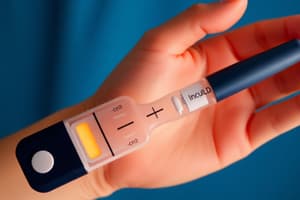Podcast
Questions and Answers
What percentage of diabetes mellitus is accounted for by Type 1 DM?
What percentage of diabetes mellitus is accounted for by Type 1 DM?
- 20-30%
- 70-80%
- 5-10% (correct)
- 50-60%
What is another name for Type 1 DM?
What is another name for Type 1 DM?
- Insulin-independent diabetes
- Gestational diabetes
- Insulin-dependent diabetes (correct)
- Type 2 diabetes
At what stage of life does Type 1 DM typically present?
At what stage of life does Type 1 DM typically present?
- Only in older adults
- Only in childhood and early adulthood
- At any stage of life (correct)
- Only in middle age
What is the prevalence of Type 1 DM in the USA?
What is the prevalence of Type 1 DM in the USA?
How would you describe the onset of Type 1 DM?
How would you describe the onset of Type 1 DM?
What type of defects can lead to insulin action DM?
What type of defects can lead to insulin action DM?
What pancreatic disease can cause DM?
What pancreatic disease can cause DM?
What is an example of a genetic disease that can cause DM?
What is an example of a genetic disease that can cause DM?
What type of neoplasia can cause DM?
What type of neoplasia can cause DM?
What is a disease of the pancreas that can cause DM?
What is a disease of the pancreas that can cause DM?
What is the primary goal of administering insulin?
What is the primary goal of administering insulin?
What is the condition required to change to 5% dextrose with 0.45% sodium chloride solution?
What is the condition required to change to 5% dextrose with 0.45% sodium chloride solution?
What is the primary indication for administering 5% dextrose with 0.45% sodium chloride solution?
What is the primary indication for administering 5% dextrose with 0.45% sodium chloride solution?
What is the concentration of sodium chloride in the solution administered when serum glucose is less than 200 mg/dL?
What is the concentration of sodium chloride in the solution administered when serum glucose is less than 200 mg/dL?
What is the concentration of dextrose in the solution administered when serum glucose is less than 200 mg/dL?
What is the concentration of dextrose in the solution administered when serum glucose is less than 200 mg/dL?
What is the formula for calculating the glucose lowering effect per unit of rapid-acting insulin?
What is the formula for calculating the glucose lowering effect per unit of rapid-acting insulin?
What is the glucose lowering effect per unit of rapid-acting insulin if the TDI is 45 units?
What is the glucose lowering effect per unit of rapid-acting insulin if the TDI is 45 units?
What is the purpose of the 1800 rule?
What is the purpose of the 1800 rule?
If the TDI is increased, what happens to the glucose lowering effect per unit of rapid-acting insulin?
If the TDI is increased, what happens to the glucose lowering effect per unit of rapid-acting insulin?
What unit of measurement is used to express the glucose lowering effect in the 1800 rule?
What unit of measurement is used to express the glucose lowering effect in the 1800 rule?
What is the association of TSH levels above 10 mIU/L with?
What is the association of TSH levels above 10 mIU/L with?
What is the controversy surrounding the treatment of TSH levels above 10 mIU/L?
What is the controversy surrounding the treatment of TSH levels above 10 mIU/L?
In which age group has the use of levothyroxine been shown to reduce heart disease?
In which age group has the use of levothyroxine been shown to reduce heart disease?
What is the effect of levothyroxine on heart disease in older patients?
What is the effect of levothyroxine on heart disease in older patients?
What is the goal of treating TSH levels above 10 mIU/L with levothyroxine?
What is the goal of treating TSH levels above 10 mIU/L with levothyroxine?
Flashcards are hidden until you start studying
Study Notes
Type 1 Diabetes Mellitus (DM)
- Cellular-mediated beta-cell destruction leads to insulin deficiency, requiring insulin for survival.
- Accounts for 5-10% of DM cases.
- Also known as insulin-dependent diabetes.
- Prevalence in the USA is approximately 0.12% (around 340,000 individuals).
- Presents in childhood, early adulthood, or any stage of life.
- Typically symptomatic with a rapid onset in childhood, but can have a slower onset in older adults.
Other DM Types
- Genetic defects in beta-cell function or insulin action.
- Diseases of the pancreas, such as pancreatitis, neoplasia, or cystic fibrosis.
Insulin Therapy
- "1800 Rule" formula: 1800/TDI = # mg/dL of glucose lowering per 1 unit of rapid-acting insulin.
- Example: TDI 60 units → 1800/60 = 30 mg/dL reduction in blood glucose concentration per 1 unit of rapid-acting insulin.
- Switch to 5% dextrose with 0.45% sodium chloride when serum glucose is less than 200 mg/dL.
- Goal of insulin therapy is to stop ketosis, not to normalize glucose concentration.
Thyroid-Stimulating Hormone (TSH) and Coronary Heart Disease
- TSH > 10 mIU/L associated with increased risk of coronary heart disease.
- Treatment: Controversial, but may involve using levothyroxine and potentially reducing heart disease in younger patients (40-70 years old), although not in older patients (>70 years old).
Studying That Suits You
Use AI to generate personalized quizzes and flashcards to suit your learning preferences.





